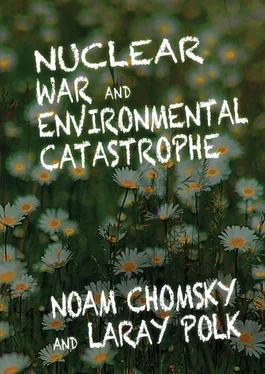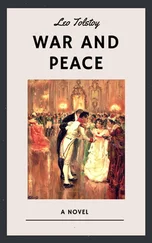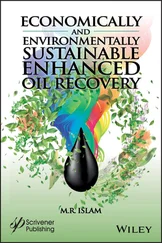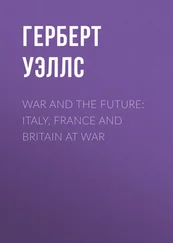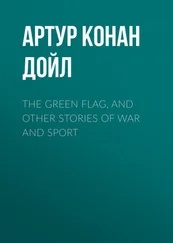It’s quite interesting if you think about it sociologically. The faculty of today are the students of a few years ago, but the shift in institutional role completely changed their attitudes. So the students were outraged and the faculty thought it was fine.
Incidentally, there are worse cases than this not involving the universities, but the press won’t report on them. Reagan and Bush were practically in love with Saddam Hussein—after the US basically won the war for Iraq in the Iraq-Iran War, Bush wanted to increase aid to Iraq over a lot of objections from the Treasury Department and others, mostly on economic grounds, but he wanted it. In fact, in 1989 Bush invited Iraqi nuclear engineers to the United States for advanced training in nuclear weapons production. [16] See Gary Milhollin’s testimony, “U.S. Export Control Policy toward Iraq,” C-SPAN Video Library (C-SpanVideo.org), October 27, 1992. On Iraqi scientists invited by the DOE to attend a symposium on detonation physics, see Martin Hill, “Made in the USA: How We Sold Secrets to Iraq That Helped Saddam Hussein Go Nuclear,” Mother Jones , May/June 1991. See also Mark Clayton, “The Brains behind Iraq’s Arsenal: US-Educated Iraqi Scientists May Be as Crucial to Iraq’s Threat as Its War Hardware,” Christian Science Monitor , October 23, 2002.
Then, in 1990, he sent a high-level senatorial delegation to Iraq led by Bob Dole (later a presidential candidate), with Alan Simpson and other big shots, and their mission was to convey Bush’s greetings to his friend Saddam and also to inform him that he should disregard criticisms that he hears in the American press. They promised Saddam that they would remove someone from the Voice of America who was being critical of Saddam. This was long after all of his worst atrocities—the Anfal massacre, the Halabja massacre—which the Reagan administration tried to cover up, said they were done by the Iranians, not by Saddam. All of that has been deep-sixed. You can find it in congressional hearings, but nobody will report it or comment on it. [17] As early as 1983, US officials knew about Iraq’s “almost daily use” of chemical weapons against the Kurds and Iranians. National Security Archive Electronic Briefing Book No. 82, s.v. “Document 25.” In 1990, almost a year after Reagan left office, the US Marine Corps released a manual reiterating Iran, not Iraq, had employed chemical weapons: “Blood agents were allegedly responsible for the most infamous use of chemicals in the war—the killing of Kurds at Halabjah. Since the Iraqis have no history of using these two agents—and the Iranians do—we conclude that the Iranians perpetrated this attack. It is also worth noting that lethal concentrations of cyanogen are difficult to obtain over an area target, thus the reports of 5,000 Kurds dead in Halabjah are suspect.” Marine Corps Publications Electronic Library, s.v. “FMFRP 3-203,” December 1990, 100. In 2002 Pres. Bush reversed position: “The Iraqi regime has plotted to develop anthrax and nerve gas and nuclear weapons for over a decade. This is a regime that has already used poison gas to murder thousands of its own citizens, leaving the bodies of mothers huddled over their dead children…. This is a regime that has something to hide from the civilized world.” George W. Bush, State of the Union Address (January 29, 2002).
That’s even worse than what was happening with Iran under the shah. The record is not a very pretty one if you look at it, and it certainly is not one of trying to reduce proliferation.
How can we be sure that any government is going to remain stable? For example, when the Iranian students came, the shah was in power, nobody knew that the Islamic uprising was coming—
They don’t care whether it’s Islamic or not. Take, say, Pakistan, in the 1980s: Pakistan was under the rule of a dictator, the worst of their many dictators, Zia-ul-Haq, who was also pushing a radical Islamist agenda and was receiving extensive funding from Saudi Arabia. They were trying to Islamize society, that’s when they were starting to set up these madrassas all over where the kids just study the Koran and radical Islam and so on. Saudi Arabia is the center of radical Islam, the most extreme fundamentalist state anywhere, and Reagan was supporting it. [18] The Reagan-Zia alliance began when the US and its European and Arab allies sought to arm the mujahideen’s “jihad against the Soviet Union” in Afghanistan. The CIA, in partnership with Pakistani and Saudi intelligence agencies, funded the arming and training of an estimated thirty-five thousand Islamic militants from forty-three Muslim countries in Pakistani madrassas between 1982 and 1990. In return, Reagan agreed not to question Zia’s policies: torture, drug trafficking by the army, and Pakistan’s nuclear weapons program. According to journalist Ahmed Rashid, “This global jihad launched by Zia and Reagan was to sow the seeds of al Qaeda and turn Pakistan into the world center of jihadism for the next two decades…. Reagan was to severely compromise the U.S. stance on nuclear proliferation by declining to question Islamabad’s development of nuclear weapons—as long as Zia did not embarrass Washington by testing them.” Descent into Chaos: The United States and the Failure of Nation Building in Pakistan, Afghanistan, and Central Asia (New York: Viking, 2008), 9, 38–39.
They don’t care about radical Islam.
Like al-Qaeda in Afghanistan, bin Laden before—
The US supported them. And in fact, they explained why. It had nothing to do with liberating Afghanistan. The head of the CIA mission in Islamabad, that’s where the planning was going on, was frank about it. Basically he said, “We don’t have any interest in liberating Afghanistan, what we want to do is kill Russians.” And this is their chance. Brzezinski, to paraphrase, said things like, “This is great, it’s paying the Russians back for Vietnam.” [19] According to CIA station chief in Pakistan in 1981, Howard Hart, his orders were to “Go kill Soviet soldiers.” Hart responded, “Imagine! I loved it.” Tim Weiner, Legacy of Ashes: The History of the CIA (New York: Doubleday, 2007), 384. When Le Nouvel Observateur asked Brzezinski about any regrets with the secret US involvement in Afghanistan, he replied: “Regret what? That secret operation was an excellent idea. It had the effect of drawing the Russians into the Afghan trap and you want me to regret it? The day that the Soviets officially crossed the border, I wrote to President Carter, essentially: ‘We now have the opportunity of giving to the USSR its Vietnam war’. Indeed, for almost 10 years, Moscow had to carry on a war that was unsustainable for the regime, a conflict that brought about the demoralization and finally the breakup of the Soviet empire.” David N. Gibbs, “Afghanistan: The Soviet Invasion in Retrospect,” International Politics 37 (June 2000): 242.
What were the Russians doing in Vietnam? Well, they were providing some limited support for resistance to US aggression, but that’s a crime, so we’ve got to pay them back by killing Russians and if a million Afghans die, it’s their problem.
Do you think it ever occurred to planners that al-Qaeda, Osama bin Laden, might come up with their own agenda?
Probably not. You can say the same about Hamas. Israel supported Hamas in the early days because they were a weapon against the secular PLO. [20] Andrew Higgins, “How Israel Helped to Spawn Hamas,” Wall Street Journal , January 24, 2009.
The US and Israel have quite consistently supported radical Islamic stands and it goes way back. Back in the early ’60s—in fact, the ’50s and the ’60s—there was a major conflict in the Arab world between Nasser, who was the symbol of secular nationalism, and Saudi rulers, who were the guardians of extremist, radical Islam. Who did the US support? The Saudis, of course. They were afraid of secular nationalism.
Читать дальше
